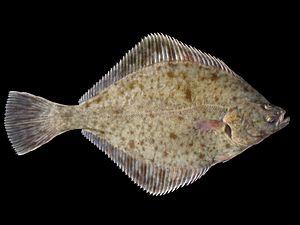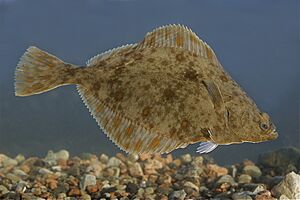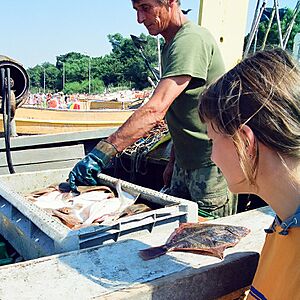European flounder facts for kids
Quick facts for kids European flounder |
|
|---|---|
 |
|
 |
|
| Conservation status | |
| Scientific classification | |
| Synonyms | |
|
The European flounder (Platichthys flesus) is a type of flatfish. It lives in the coastal waters of Europe. You can find it from the White Sea in the north to the Mediterranean Sea and Black Sea in the south. This fish has also accidentally traveled to the United States and Canada. It got there in the water carried by ships. People catch European flounders to eat.
This fish has an oval shape. Usually, its eyes are on its right side. It typically grows to about 30 centimeters (12 inches) long. Some have been found as long as 60 centimeters (24 inches). The top of the flounder is often dull brown or olive green. It has reddish spots and brown patches. This helps it change color to match its surroundings. This is a great way for it to camouflage itself. The bottom side is shiny white. This is why it's sometimes called the white fluke. Along its side, it has small bumps. These bumps are also found near its top and bottom fins.
Contents
What Does a European Flounder Look Like?
The European flounder is a flatfish with an oval body. Its width is about half its length. The longest one ever found was 60 centimeters (24 inches) long. The heaviest was 2.93 kilograms (6.5 pounds). But most adult flounders are about 50 centimeters (20 inches) long.
This fish is flattened from side to side. It swims and rests on one side. As it grows, its eyes usually move to the right side of its head. So, what looks like its top is actually its right side. About 30% of these fish have their eyes move to the left side instead. The flounder has a small mouth at the front of its blunt snout. Its top side can be fawn, olive green, or light brown. It has spots and larger dark brown patches. Some also have reddish spots. The bottom side is a shiny, pearly white. This gives it the common name "white fluke."
A line runs along the middle of its top side. This is called the lateral line. It helps the fish sense things in the water. The top fin, called the dorsal fin, runs from its head to its tail. It has no sharp spines, only soft rays. The bottom fin, called the anal fin, also runs along its body. It also has no spines and only soft rays. The skin of the flounder feels rough. It has prickly bumps near the bases of its top and bottom fins. There are also large scales near the lateral line. Its tail fin has a squared-off end.
Where Do European Flounders Live?
The European flounder is originally from the northeastern Atlantic Ocean and the Mediterranean Sea. Its home range goes from the Barents Sea, White Sea, and Baltic Sea. It also lives near Greece, Turkey, the Black Sea, and the coast of North Africa. It has also been found in Iran. It has settled off the eastern coasts of Canada and the United States. It likely got there by accident in the water carried by ships.
You can usually find flounders from the shallow shore down to about 100 meters (330 feet deep). They live on sandy, rocky, or muddy bottoms. Their spotted colors help them blend in. This makes them hard to see.
The European flounder can also live in estuaries. These are places where rivers meet the sea. They can handle water that is not very salty. Unlike other flatfish, they often spend part of their lives in freshwater. They regularly swim into rivers. In the British Isles, they have been found far inland in rivers. For example, they've been seen in the River Severn and the River Wyre. Unlike the Atlantic salmon, flounders eat in the rivers. Then they swim back to the sea before they lay their eggs.
Life and Habits of the European Flounder
The European flounder lives and eats on the seabed. It also feeds in the water just above the bottom. It is mostly active at night. During the day, it rests on the sea floor. It often buries itself partly in the sand or mud. It eats small creatures that live on the seabed. These include clams, shrimps, worms, snails, and small fish.
Reproduction and Life Cycle
European flounders leave freshwater in the autumn. You can often catch them in estuaries when it first gets cold. Then, the fish move into deeper water for the winter. In the spring, they travel to places where they lay their eggs. They can travel about 5 to 7 kilometers (3 to 4 miles) each day. They do not eat while they are traveling.
Flounders lay their eggs between January and July. It happens later in places further north. A female can release about a million eggs. These eggs float in the water. The eggs hatch after 6 to 11 days. The time depends on how warm the water is. The baby flounders are tiny and float with the currents. They drift towards the coast. They use the tides to move into estuaries and rivers. Young flounders live in shallow waters, estuaries, and rivers. They prefer water that is not very salty.
Flounders become ready to have babies when they are still small. Males are ready when they are about 11.5 centimeters (4.5 inches) long. Females are ready when they are about 18 centimeters (7 inches) long. Sometimes, European flounders can breed with European plaice. This creates a mixed species. This is common in the western Baltic Sea. In the Baltic Sea, some European flounders breed in shallow waters. This is different from the usual deep-water breeding. These populations are now known to be a different species called the Baltic flounder. The Baltic flounder has become more common than the European flounder over the last 5,000 years. This is due to changes in the environment.
European Flounders and Humans
People eat European flounders. But they are not as popular as the European plaice or common sole. The most important places for catching flounders are the Baltic Sea and near the Netherlands and Denmark. In 2010, people caught about 19,000 tons of flounders worldwide. Most were caught by dragging nets along the bottom of the sea. The fish are sold fresh or frozen. You can fry, boil, steam, bake, or microwave them.
Scientists have found that male European flounders in polluted estuaries can be affected by chemicals. These chemicals in the water can impact their health. However, flounders are less sensitive to these chemicals than some other fish, like the freshwater rainbow trout.
Status of the European Flounder
The IUCN (International Union for Conservation of Nature) says the European flounder is of "Least Concern". This means it is not currently threatened. It has a large population and lives in many places. It is common in almost all areas where it lives. The number of flounders might be going down a little. But it's not enough to put them in a higher risk group. However, in parts of the Baltic Sea, changes in the environment have caused problems for the European flounder's breeding areas. In some places, like the Gulf of Finland, the European flounder has almost disappeared. This has left the Baltic flounder as the main species there.



